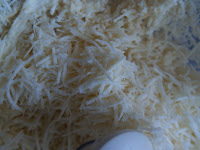
Jean's Pink Fish is the most wonderful retro recipe, a real throwback to the 1950s and 1960s ... we may think it old-fashioned, but everyone fell on it at lunch on Sunday, even those who, like me, had never eaten Jean's version. Anna was amazed, it's not her normal thing at all - she made it to honour her grandmother, and was slightly embarrassed that it didn't go with the rest of lunch.
It's a tinned salmon mousse, with rice. I've had plenty of salmon mousse, but never with rice - surprisingly, a good addition; thrifty, too.
In the '60s, everyone used to have a ring mould; setting sweet and savoury dishes with gelatine was all the rage. By the 1980s, it was a forgotten art, and, soon after I married, both my mother-in-law and my stepmother passed me on their no-longer-needed ring moulds. I've used them intermittently, mostly for cakes .... but so intermittently that yesterday, where was the small one when I needed it??? I just hope I haven't given it to Sue Ryder or Oxfam! So I made my pink fish in a small loaf tin instead - not so pretty, but just as effective. I used to have a fish mould, but I can't find that, either - and you try buying one of those now: teddy bears, numbers, stars, hearts - but no fish!
Fish mousse became fish pate (I remember making one with a lot of lemon, and stuffing it back into the hollowed-out lemons), as we all discovered how fiddly it was to use powdered gelatine. These days you can buy sheet gelatine in just about every supermarket, so suddenly it's got easy again ... you just soak the leaves in cold water for a few minutes, and then, when you're ready, squeeze out the water, and slide them into your warm ingredients, whereupon they dissolve instantly.
Pink fish is a very useful starter, because you can make it a couple of days ahead, and it's a doddle, too (I did most of it one-handed while chatting to Menna on the phone). The basic ingredients are likely to be in your kitchen - tinned salmon, rice, yoghurt, tomato ketchup, Worcester sauce, tabasco. You use the tin to measure all the other ingredients, another plus.
Jean's version is delicious, and very much of its time - lashings of cream, mayo from a bottle (it had just been invented). I've updated it to make it lighter, and find that the finished dish tastes sharper, not so sickly sweet (all that cream). Next time I make it, I'll update it again, using fresh salmon rather than tinned, and fresh chilli rather than tabasco. It could also be made with lemony-herby flavourings rather than the chilli.
Jean's Pink Fish
1 tin red salmon
1 tin cooked rice
1/2 tin mayo
1/2 tin double cream
1/2 tin milk
enough gelatine to make it set (2 leaves for a small tin, 4 for a big tin)
tomato ketchup
Worcester sauce
tabasco
salt and pepper
Soak the gelatine in a little cold water. Meanwhile, drain the salmon and mash it in a little bowl. Put cooked rice into the tin and add it to the salmon. Pour the cream and mayo into the tin, then add this to the bowl. Mix well. Season with sauces. The tk will make it pink which is good, but will also add sweetness, which may become too much in this creamy version, so go carefully.
Now measure half a tin of milk, and heat this gently in a small pan (don't let it boil). When it's a little more than blood temperature, take it off the heat, squeeze out the gelantine leaves and add them. Stir, and when you're sure they're dissolved, add them to your paste. Pour it into your prepared mould (either grease it, or line it with clingfilm). This will take a couple of hours in the fridge to set, and will keep, well wrapped, for at least a couple of days.
You get the full '60s flavour of the thing if you make it in a fish mould, and decorate the resulting mousse with overlapping scales made from finely sliced cucumber. But you may be saved from yourself by the lack of a fish mould. In Anna's case it was a tribute to her grandmother.
Joanna's pink fish
1 tin red salmon
1 tin cooked rice
1 tin 0% Greek yoghurt
1/2 tin skimmed milk
gelatine (see above for quantities)
tomato ketchup
Worcester sauce
tabasco
salt and pepper
Follow the method above. I used a mixture of white rice and wild rice, because that's what there was, but I think that white rice alone would be a better bet, as the wild rice was quite assertive. Brown rice would be worth trying.
I definitely preferred the taste of this one - sharper, tangy-er. I suspect it would be really good made with fresh salmon, and I know that you could have fun changing the flavourings.
A small tin of salmon made enough mousse to fill a small loaf tin, which would cut into eight slices.
Last week Anna made Jean's original sauce for this, but she said it was too disgusting to eat: cream, tk, tabasco ... more of the same, in other words. I think it would be worth trying a green sauce of some sort - capers, vinegar, herbs. That's what I'll do this evening, anyway.
PS if you're one of the many people who have asked for Anna's passionfruit tart recipe - I'm going to phone her tonight to get instructions - they'll be here before the weekend, fingers crossed














































